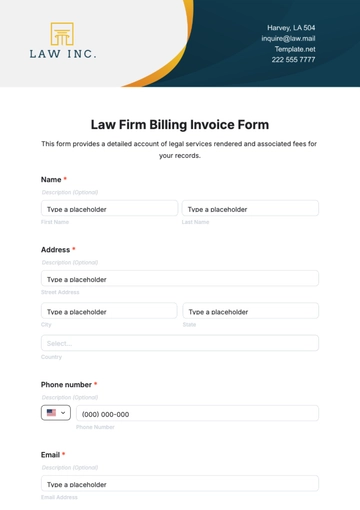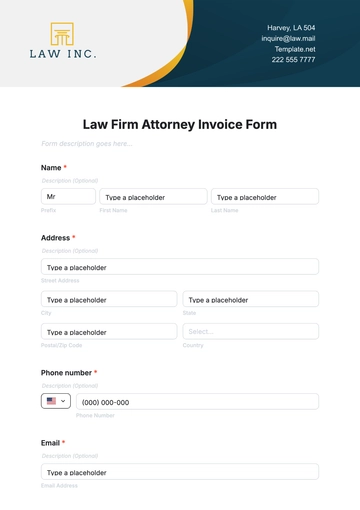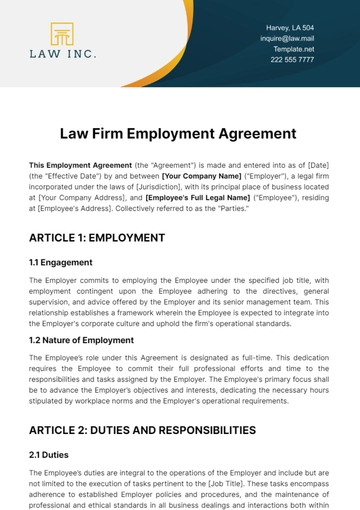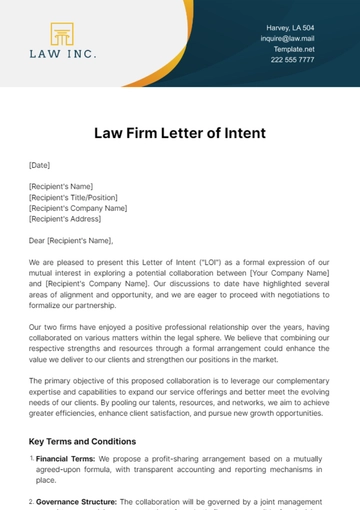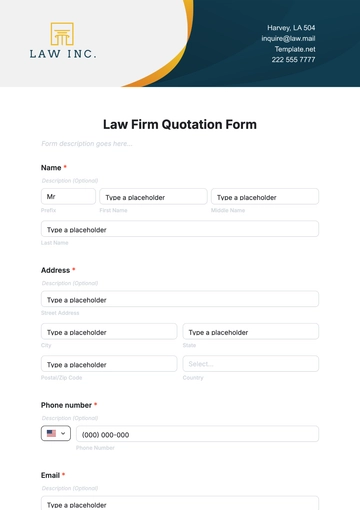Free Law Firm Financial Guide

I. Aligning Budgets with Strategic Goals
Initiating a robust budgeting process that aligns with the strategic goals of your law firm is crucial for sustaining financial health and steering the firm toward its long-term objectives. Begin by constructing a comprehensive budget framework that forecasts revenue by closely analyzing billable hours, retainer fees, and outcomes of contingent cases. It's essential to set financial targets that are not only ambitious but also realistic, grounded in historical performance data and current market trends.
Efficient resource allocation is key to maximizing profitability. This involves identifying high-yield activities and allocating more resources towards them while cutting back on less productive areas. Departments should be encouraged to operate within their financial confines while still aiming to surpass set performance metrics.
It is also imperative to have a dynamic review process in place. Regularly revisiting the budget allows for adjustments in response to fluctuating financial conditions, ensuring the firm remains on track to meet its strategic goals. Engage department heads in the budgeting process to ensure their insights are integrated, which helps in fine-tuning the budget to better support specific departmental objectives and overall firm strategies.
Revenue Forecasting Tools:
Time tracking software for billable hours
Case management systems for monitoring contingent cases
Client retainer management applications
Resource Allocation Strategies:
Prioritization of high-margin legal services
Investment in technology for efficiency
Training for legal staff to enhance productivity
Budget Review and Adjustment Mechanisms:
Quarterly financial reviews
Real-time budget tracking dashboards
Feedback sessions with department heads
II. Managing Cash Flow
Effective cash flow management is vital for maintaining financial stability and ensuring the firm meets its financial obligations consistently. By implementing strategic practices to monitor and enhance cash flow, your law firm can optimize financial operations and mitigate risks associated with liquidity. Below is a detailed breakdown of key cash flow management strategies, tools, and practices that can significantly improve your firm's financial health.
Category | Strategy | Tools | Description |
|---|---|---|---|
Monitoring | Daily Cash Flow Tracking | Financial software | Track daily cash inflows and outflows to identify trends and potential shortfalls. |
Regular Financial Reporting | Accounting systems | Generate weekly, monthly, and quarterly reports to maintain oversight of cash positions. | |
Enhancements | Accelerate Receivables | Online payment solutions | Implement faster payment methods for clients to improve cash inflow rates. |
Delay Payables | Vendor management software | Extend payable cycles where possible without incurring penalties to better manage outflows. | |
Liquidity Management | Maintain Liquid Reserves | Investment management tools | Keep a portion of funds in liquid investments to cover sudden financial needs. |
Line of Credit Establishment | Banking relationships | Secure a line of credit to utilize in case of cash flow interruptions. | |
Risk Mitigation | Diversify Client Base | CRM software | Reduce dependency on a few large clients by diversifying your client portfolio. |
Regular Financial Health Checks | Financial advisors | Engage with financial experts to review and advise on cash flow strategies. |
Implementing these strategies will ensure that your law firm not only stays financially sound but also remains well-prepared for any unforeseen financial challenges. This approach fosters a proactive stance towards financial management, safeguarding the firm's interests and future.
III. Ensuring Compliance and Ethical Standards
Upholding stringent compliance and ethical standards is imperative not only to satisfy regulatory requirements but also to sustain the trust and confidence of clients and the broader legal community. This commitment is fundamental to the integrity and reputation of your law firm. A proactive approach involves continuous education, rigorous monitoring, and the adoption of stringent internal controls to manage both financial and ethical risks.
Initiate comprehensive training programs tailored for all levels of the firm to ensure that every team member is well-versed in current compliance requirements and ethical practices. Regular workshops and seminars should be conducted to address updates in laws and regulations, focusing on their practical implications for day-to-day operations. Additionally, maintain meticulous and transparent records of all financial transactions to ensure that every financial action can be accounted for, enhancing transparency and accountability.
Frequent audits of client funds are crucial to ensure these are managed accurately and with the highest level of integrity. Such audits help in identifying discrepancies early and safeguard against potential misappropriation or financial inaccuracies. Implement strict financial controls to prevent misconduct, such as segregation of duties in financial roles and the use of compliance management software to monitor transactions continuously.
Stay adaptive to changes in legal and financial obligations by regularly updating your firm’s practices and policies in response to new legislation or regulatory guidance. This dynamic approach ensures that your firm not only complies with legal requirements but also upholds a high ethical standard that reinforces client trust and legal credibility.
Compliance Training Components:
Annual mandatory ethics training for all staff
Specialized seminars on changes in law and regulatory requirements
Case studies on ethical dilemmas and legal consequences
Financial Record-Keeping and Auditing Practices:
Use of advanced accounting software for real-time financial tracking
Quarterly audits of client trust accounts
Regular reviews and reconciliations of financial statements
Controls and Procedures for Financial Management:
Clear protocols for financial decision-making
Dual-authorization for significant transactions
Regular updates to internal compliance manuals based on legal changes
By embedding these practices into the fabric of your firm’s operations, you enhance the overall governance and ensure a culture of integrity and compliance. This not only mitigates risks but also positions the firm as a leader in ethical legal practice.
IV. Financial Reporting and Analysis
Accurate and detailed financial reporting is critical for gauging your law firm's financial health and steering strategic decision-making. By consistently analyzing financial data through a variety of reports, the firm can identify trends, address issues, and seize opportunities to enhance profitability. This section outlines the key types of financial reports used, their frequency, and the specific metrics they track to provide a comprehensive view of the firm's financial status.
Below is a detailed table that provides an overview of the essential financial reports, their objectives, and the insights they offer:
Report Type | Frequency | Key Metrics | Purpose |
|---|---|---|---|
Monthly Financial Statements | Monthly | Revenue, expenses, net profit/loss | Track regular financial activity to detect early signs of deviations from budgeted performance. |
Quarterly Performance Reviews | Quarterly | Revenue by practice area, client retention rates, expense breakdown | Evaluate the effectiveness of business strategies and operational adjustments. |
Annual Profitability Analysis | Annually | Profit margin, cost per case, client acquisition cost | Assess year-long performance, strategic direction, and financial planning for upcoming year. |
Client Account Audits | Biannually | Client fund accuracy, timely billing | Ensure compliance and accuracy in client fund management and billing practices. |
Cash Flow Analysis | Quarterly | Cash inflow and outflow, liquidity status | Monitor liquidity and cash reserves to manage financial obligations and investment opportunities. |
These reports serve as vital tools for law firm managers and partners to maintain a pulse on the financial trajectory of the firm. Utilizing these insights can help in making informed decisions that align with both short-term financial management and long-term strategic goals. Regularly updating and reviewing these reports ensures that the firm remains agile in its financial operations, ready to adapt to changes in the legal market and client demands. This structured approach to financial analysis not only supports fiscal responsibility but also drives growth and profitability.
V. Integrating Technology in Financial Operations
The adoption of advanced technological tools is essential for enhancing the efficiency and accuracy of your law firm's financial operations. Through the strategic implementation of various software solutions, the firm can streamline processes, increase transparency, and leverage data-driven insights for better financial decision-making. This section details the types of technologies that are transformative for financial operations, their specific uses, and the benefits they offer.
Below is a detailed table that outlines key technological integrations for financial management, their applications, and their impact on the firm’s operations:
Technology | Application | Purpose | Benefits |
|---|---|---|---|
Accounting Software | Overall financial management | Streamlines accounting processes, integrates financial data for easy access | Increases accuracy, reduces manual entry, provides real-time financial status |
Client Payment Systems | Simplifying revenue collection | Facilitates faster and more efficient payment processes from clients | Enhances cash flow, improves client convenience |
Automated Billing Systems | Invoicing and billing | Reduces human error in billing, automates repetitive tasks, and ensures timely billing | Saves time, minimizes disputes, and secures revenue |
Financial Analytics Tools | Analysis of financial data | Provides deeper insights into financial metrics, trends, and performance indicators | Supports strategic decision-making, identifies financial opportunities and risks |
Regular Software Updates and Training | Continuous improvement of financial operations | Keeps software and skills up to date with the latest advancements in financial technology | Ensures effectiveness, security, and competitiveness of financial operations |
Integrating these technologies into your financial operations not only streamlines workflows but also provides a competitive edge by enabling faster responses to financial insights and market changes. Regular updates and thorough training ensure that your team is proficient with these tools, maximizing their potential benefits. This technological empowerment of financial operations lays a strong foundation for sustainable growth and enhanced profitability.
- 100% Customizable, free editor
- Access 1 Million+ Templates, photo’s & graphics
- Download or share as a template
- Click and replace photos, graphics, text, backgrounds
- Resize, crop, AI write & more
- Access advanced editor
Expand your law firm's financial strategy with Template.net's Law Firm Financial Guide Template. Fully customizable and editable in our Ai Editor Tool, our adaptable platform enables a comprehensive interpretation of your financial position. Tailored to the demands of the marketing industry, this dynamic guide is designed to initiate growth and stability. Leveraging our innovative template, maximize your profits, streamline financial operations, and drive your firm's success. Empower your financial journey today with Template.net.














